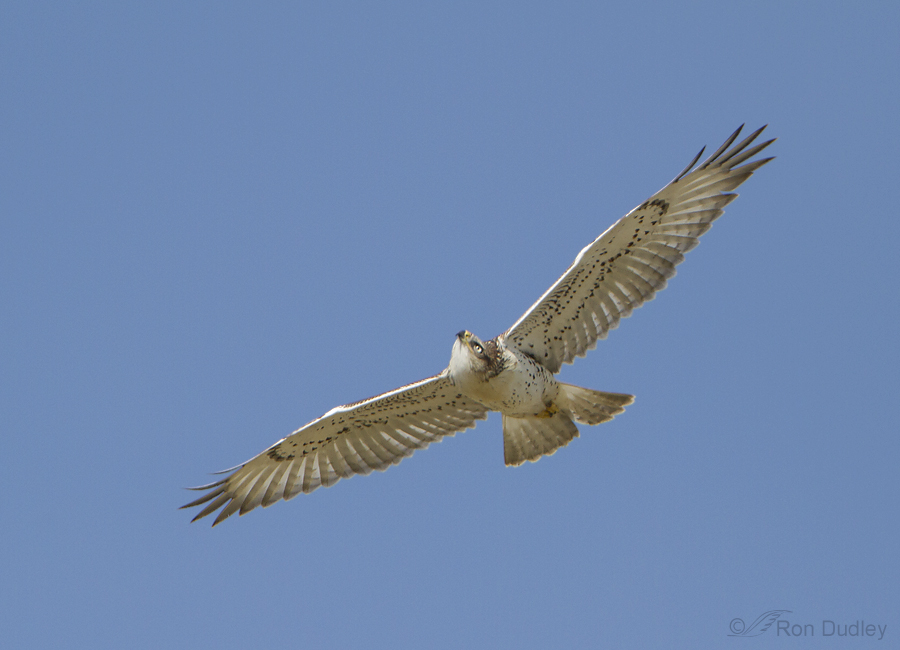Tag: buteo regalis
Ferruginous Hawk In Head-on Flight
The Ferruginous Hawk is the largest, most powerful buteo in North America. They have a broad chest, wide gape, large head and long, narrow-tipped wings. Unlike most other buteos they often perch on the ground. Their huge nests, typically constructed in isolated trees or on cliffs, were often constructed of bison bones and wool before the elimination of that massive animal from the western plains. This species is often compared to the Golden Eagle with which it has much in common and they are fully deserving of their apt scientific name, Buteo regalis. 1/4000, f/6.3, ISO 500, 500 f/4, 1.4 tc, natural light, not baited, called in or set up This bird had been perched on an old fence post in Utah’s west desert (background is the Stansbury Mountains) and I was able to capture it in flight soon after it lifted off. I like the blood on the left foot and the somewhat unusual wing position as it took off mostly in my direction. This wing position is seldom seen in photographs because the wing would obscure the head in the much more common side view. Typically these birds don’t take off toward the photographer from a low perch. Ron
Ferruginous Hawk On A Rustic Perch
Ferruginous Hawks are very impressive birds when you get this close to them. They are massive broad-winged hawks with a wide gape, large head and burly chest. They are our largest buteo and share many characteristics with the Golden Eagle. Last week in Montana I came across this bird on what is apparently a favorite perch – a rustic entrance gate to an irrigated farm in a small, beautiful and lush valley in Beaverhead County. I say “favorite perch” because I found this same bird (apparently) on the same gate, and in the same position, last month. 1/2500, f/7.1, ISO 500, 500 f/4 These hawks are “sit and wait” hunters, which is exactly what this bird was doing. Their preferred prey is ground squirrels and prairie dogs and based on the number of badger holes in the valley I’d guess that there’s plenty of ground squirrels available. This is another version of the same image, cropped differently and more closely to better show the group of gnats (no-see-ums) swarming around the head of the hawk (to the left, I cloned them out in the first image). In some ways the biologist in me actually prefers the second version. 1/2000, f/8, ISO 500, 500 f/4 When it took off it was facing away and I clipped a wing-tip but I decided to include this image anyway to show the bird up close and in flight. Ron
Finally – A Cooperative Ferruginous Hawk
We had to go all the way to Montana to find a cooperative Ferruginous Hawk but three days ago we found one in Beaverhead County. My files on this species are woefully lacking and it’s not because I haven’t worked hard at getting acceptable images of them. I’ve made many trips to the island mountain ranges of western Utah specifically to photograph this handsome raptor but until this last week I could count the number of nice images I had of them on one hand. They just won’t let me approach them. This single bird made the enitre trip well worth it. The Ferruginous Hawk has been described as “the largest, most powerful and grandest of our buteos – a truly regal bird”. In fact the scientific name for the species is Buteo regalis – a fitting descriptor of this hawk. 1/4000, f/6.3, ISO 640, 500 f/4, 1.4 tc We found this bird on our way home, beside a long and isolated dirt road and I was even pulling my camping trailer which didn’t spook it. This first shot was taken from some distance because I assumed it would fly off when we got closer. It didn’t. Here it looks like the bird is upset with us for coming along but I think it was reacting to another Ferruginous Hawk that was in the vicinity (though we didn’t yet know it was there). This road has quite a bit of traffic (horse trailers, logging trucks etc) considering how isolated it is and since these birds are “sit and wait hunters” I believe this…
Ferruginous Hawks of Utah’s West Desert
The Ferruginous Hawk is a strikingly handsome raptor with its stocky build, white underparts and rufous coloration. It is the largest North American hawk and has several distinctive features including the fact that its legs are feathered all the way down to the feet. The Rough-legged Hawk is the only other hawk on this continent to share this trait. I’ve had a devil of a time getting many photos of this species that I like. For me they’ve been difficult to find in the first place and then there’s the issue of getting near enough to them for quality images as they generally don’t allow a close approach. My best luck with the species has been in the foothills of Utah’s west desert mountain ranges. 1/1250, f/7.1, ISO 500, 500 f/4, 1.4 tc I found this bird earlier this week and spent quite a while “sneaking” up on it very slowly in my pickup. I ended up getting reasonably close before it flew off. The hawk is relaxed enough with me in its presence to perform a nice wing stretch. 1/1000, f/6.3, ISO 500, 500 f/4, 1.4 tc These birds tend to hunt high off the ground and no matter how slowly I try to approach them while they’re in the air they usually maintain a minimum distance from my truck that is too far away for good photographs. Very occasionally however one will apparently become curious about me and fly in close – always with its eye on me and not on any potential prey on the ground. …


